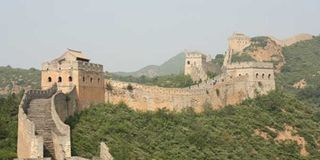The story of China as seen by Kenyan visitors

The Great Wall of China. Kenyans from different walks of life and diverse backgrounds who have had memorable encounters with China have written well thought out pieces. PHOTO | FILE
What you need to know:
- The book comprises well thought out pieces written by Kenyans from different walks of life and diverse backgrounds who have had memorable encounters with China. The writers range from university students, journalists and employees of Chinese companies to other beneficiaries of the increased Chinese presence in Kenya.
- Throughout the entire anthology, the increasingly visible presence of the Chinese in Kenya is vividly brought out. Since Chinese navigator Zheng He stopped at Malindi hundreds of years ago, China-Kenya relations have progressively grown culturally, politically, economically, socially and technologically.
- Ruth narrates how her casual attempt to study Chinese at the newly inaugurated Confucius Institute at the University of Nairobi turned out to be a life changer for her. Her first lesson was taught by no less than the then Chinese ambassador to Kenya Guo Chongli! Since then, she has pursued her Chinese dream to this day.
The recently published collection of the award winning works at the My China/Kenya story writing contest is an interesting, insightful and informative narration of Kenyans’ experience of and about China.
The book comprises well thought out pieces written by Kenyans from different walks of life and diverse backgrounds who have had memorable encounters with China. The writers range from university students, journalists and employees of Chinese companies to other beneficiaries of the increased Chinese presence in Kenya.
The anthology itself is rendered in simple, precise and easily comprehensible English.
Two of the pieces in the collection are poems. Photo illustrations accompanying the pieces help the reader to visualise and appreciate the story better.
Coincidentally, the first article – under the title ‘My China Journey’ by Ruth Njeri makes for a good summary of what other contributors have to say and as it turns out, the story is quite captivating.
LANGUAGE LESSONS
Ruth narrates how her casual attempt to study Chinese at the newly inaugurated Confucius Institute at the University of Nairobi turned out to be a life changer for her. Her first lesson was taught by no less than the then Chinese ambassador to Kenya Guo Chongli! Since then, she has pursued her Chinese dream to this day.
Throughout the entire anthology, the increasingly visible presence of the Chinese in Kenya is vividly brought out. Since Chinese navigator Zheng He stopped at Malindi hundreds of years ago, China-Kenya relations have progressively grown culturally, politically, economically, socially and technologically.
The numerous infrastructural developments spearheaded by the Chinese have also been variously acknowledged in the publication. The Moi International Sports Centre, Kasarani, Thika Superhighway and the standard gauge railway stand out as the most remarkable achievements of China Kenya relations.
The book probes the long standing negative perception of the Chinese people as inhumane and callous. Whereas the Chinese are hardworking and studious people, the authors emphasise the fact that there is nowhere else you will find friendlier and more hospitable people than in China.
Also dominantly featuring in the book is the strength and uniqueness of the Chinese culture. The authors cite the Chinese New Year celebrations, Chinese music and dances, making of dumplings, Chinese calligraphy, a visit to the Great Wall and The Forbidden City as some of the most thrilling experiences for a foreigner visiting China.
More interesting is the manner in which the Chinese have been able to fuse millennia-old traditions with modernity. This culture forms the basis of a booming tourism industry in China.
The book also discredits the notion that China is the source of counterfeit and substandard goods. One of the authors wonders why the West discourages African countries from doing business with China, yet Occidental multinationals have subsidiaries all over China.
MONOTONOUS LANGUAGE
The numerous scholarship programmes initiated by the Chinese are also mentioned. In fact, quite a number of the authors are beneficiaries of the programmes.
Almost all the authors seem to have been thrilled by the diversity of the Chinese cuisine.
However, the book is written in a rather monotonous language that may not be very captivating for some readers. The stories are also rather short, making it hard to capture complete thought processes as would be helpful in exposing China.
All in all, this is a must read for all the people keen on Sino-Africa relations. It is a commendable attempt to see Africa through local prisms.
For a long time, the realities that inform our perception of China are largely based on myths. This is worsened by the fact that we feel constructed to the West from where we got our first modelling. A book like this one is thus crucial in making China more accessible.
This could also open up for classical literary works from China that still remain scarce in Africa.




